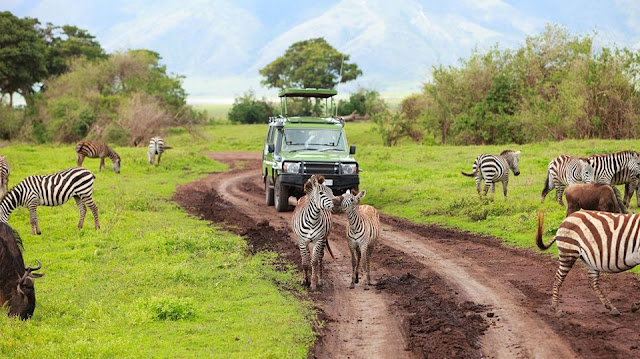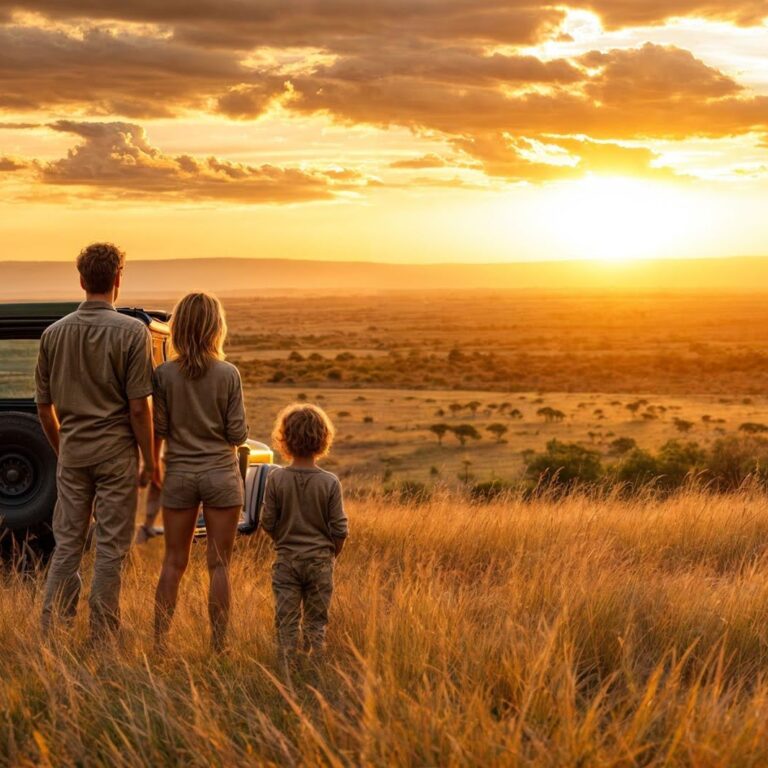The Great Migration in East Africa, involving over a million wildebeest, zebras, and other animals, is a captivating spectacle. You can witness this migration in the Serengeti National Park in Tanzania and the Maasai Mara National Reserve in Kenya. Another mesmerizing migration is the mass emergence of red-sided garter snakes in Manitoba, Canada, where thousands gather in dens before emerging in the spring. Nature’s most awe-inspiring events include breathtaking migrations, where animals embark on perilous journeys across thousands of miles. From the vast plains of Africa to the icy waters of the Arctic, these migrations are not just survival strategies—they are marvels of endurance, instinct, and beauty. Below, we delve into the world’s most captivating animal migrations and where to witness these spectacular journeys.
1. The Great Wildebeest Migration – Serengeti, Tanzania, and Masai Mara, Kenya
The Great Wildebeest Migration is one of Earth’s most Remarkable Animal Migrations across the globe iconic wildlife spectacles. Each year, approximately 1.5 million wildebeest, iconic animal migrations in Africa accompanied by zebras and antelope. Make a clockwise journey across the Serengeti-Masai Mara is where to see some of the world’s great animal migrations ecosystem nature’s most impressive animal migrations. The best time to see the migration depends on the location: from July to September, the animals cross the Mara River into Kenya’s Masai Mara, while from January to March, they gather in Tanzania’s southern Serengeti to calve the world’s most mesmerising animal migrations and where to see them.
2. Monarch Butterfly Migration – North America to Central Mexico
Every autumn, millions of Monarch butterflies undertake an incredible 3,000-mile journey from North America to the highlands of central Mexico amazing animal migrations around the world. They navigate using Earth’s magnetic fields and position of the sun. Clustering in the Oyamel forests nature’s most spectacular animal migrations. Visit the Monarch Butterfly Biosphere Reserve in Michoacán between November and March to witness forests blanketed in orange, a rare and beautiful sight.
3. Arctic Tern Migration – From the Arctic to Antarctica
The Arctic Tern’s migration is the longest migration in the animal kingdom. These small birds travel approximately 44,000 miles each year. Experiencing two summers as they move from their Arctic breeding grounds to the waters around Antarctica. For enthusiasts, bird-watching in Greenland, Iceland, or Alaska during the summer months offers a chance to see these globe-trotting birds prepare for their long journey.
4. Red Crab Migration – Christmas Island, Australia
Each year, millions of red crabs on Christmas Island in Australia undertake a synchronized migration from forest to coast. The ultimate guide to witnessing the world’s most enchanting animal migrations. This migration aligns with the lunar calendar and rainfall, creating a “red river” as they move to the sea to spawn best animal migrations to witness. November is the prime month to observe this migration, with Christmas Island National Park providing an ideal viewpoint for visitors.
5. Caribou Migration – Alaska and Northern Canada
One of the most impressive mammal migrations, caribou herds in Alaska and Canada cover up to 3,000 miles annually. Their journey follows ancient trails across tundra and rugged mountains in search of food and breeding grounds animals that migrate long distances. Visit Alaska’s Arctic National Wildlife Refuge in spring or fall to witness this epic journey and observe herds moving together across stunning landscapes.
6. Southern Right Whale Migration – South Africa and Argentina
Each winter, Southern Right Whales migrate from their feeding grounds in the Southern Ocean to warmer waters along the coasts of South Africa and Argentina. These majestic whales gather near Hermanus, South Africa, and Puerto Madryn, Argentina, to give birth and nurse their young. July to October is the peak season to observe them, with whale-watching tours offering remarkable opportunities to get up close.
7. Salmon Migration – Alaska, Canada, and the Pacific Northwest
Salmon migration is one of nature’s most dramatic journeys, as these fish swim upstream to their birthplace to spawn. Grizzly bears, eagles, and wolves follow this migration, making it a multi-species spectacle. Alaska and British Columbia in late summer and early fall offer prime spots to witness salmon struggling upstream. With popular locations including Katmai National Park and the Fraser River.
8. Zebra Migration – Botswana and Namibia
The zebra migration in Botswana and Namibia is Africa’s second-largest mammal migration, after the wildebeest migration. Zebras travel from Namibia’s dry regions to the nutrient-rich grasslands of Botswana’s Nxai Pan National Park. Between December and March, herds of zebras traverse these vast plains, providing an impressive display in a unique desert ecosystem.
9. Humpback Whale Migration – Hawaii, Mexico, and Australia
Humpback whales migrate thousands of miles from feeding areas in polar waters to tropical and subtropical areas for breeding to discover the world’s most spectacular animal migrations. Hawaii, Baja California in Mexico, and Queensland in Australia are prime locations to watch humpbacks during their migration. December through April is peak season in Hawaii, where these whales can be seen breaching and tail-slapping in Hawaiian waters.
10. Fruit Bat Migration – Kasanka National Park, Zambia
Every year, approximately 10 million fruit bats arrive in Kasanka National Park, Zambia, creating the world’s largest mammal migration. These bats migrate from the Congo Basin to feed on Kasanka’s fruit trees, filling the sky at dawn and dusk. November and December are ideal months to experience this surreal scene, with guided tours offering the best viewpoints.
11. Sardine Run – South Africa
The Sardine Run along South Africa’s Wild Coast is one of the world’s most intense migrations. Millions of sardines move in massive shoals from the cold waters of the Agulhas Bank. Attracting predators like sharks, dolphins, and seabirds to discover the world’s most spectacular animal migrations. Between May and July, you can join oceanic expeditions from Port St. Johns or East London to witness this feeding frenzy.
12. Flamingo Migration – Lake Natron, Tanzania
Lake Natron in Tanzania transforms into a flamingo haven each year. As millions of flamingos flock to this shallow soda lake to breed 10 must see animal migrations. The lake’s unique ecosystem, with its alkaline waters, provides ideal conditions for breeding. Unusual animal migrations and where to see them visit Lake Natron between August and October. To observe these graceful birds covering the lake in pink hues, creating a mesmerizing sight in the remote landscapes of the Great Rift Valley.
13. Elephant Migration – Botswana, Namibia, and Zimbabwe
Elephants are known for their long-distance migrations across Botswana, Namibia, and Zimbabwe, moving in search of water and grazing lands. Botswana’s Chobe National Park and Zimbabwe’s Hwange National Park. Are excellent destinations to witness these intelligent giants the most interesting animal migrations around the world to discover the world’s most spectacular animal migrations. During the dry season from May to November, elephants congregate around water sources, making it the best time for sightings.
Largest mammal migration in the world
The world’s largest mammal migration is a debate between the Kasanka Bat Migration in Zambia and the Great Nile Migration in South Sudan: Other 5 of the best wildlife migrations in Africa – See wildebeest, zebra, whales, turtles & bats close up en mass in a spectacle.
Kasanka Bat Migration
Between October and December, up to 10 million African straw-colored fruit bats migrate to Kasanka National Park in Zambia. These bats, also known as flying foxes, have wings that span almost three feet and bodies the size of puppies. However, the population of these bats has declined by 25–30% over the past 15 years due to bushmeat harvesting and land degradation.
Great Nile Migration
In 2023, an aerial survey recorded around 6 million antelope migrating across the Boma Badingilo Jonglei Landscape in South Sudan. This migration also includes white-eared kob, tiang, Mongalla gazelle, and Bohor reedbuck. The Great Nile Migration takes place in a 200,000 km2 ecosystem that’s important to the Sudd Swamps, the second largest wetlands in the world. However, some conservation biologists are concerned that the migration could be threatened as the country develops.







